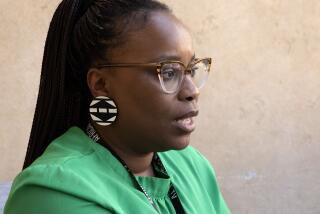MOVIE REVIEWS : Patience Brings Reward in Seeing International Films
- Share via
In a first-ever tour, eight feature films from the East-West Center’s Hawaii International Film Festival are being presented in free showings throughout the Cal State University campus system. Additionally, four of the program’s eight films will be in evening performances Sunday and Monday, at USC’s Norris Cinema Theater.
If films from such differing cultures as China, Taiwan, Korea, India, Japan and New Zealand can be said to have anything in common, it’s a time frame that American cinema prepares you for not at all. Walking into these movies cold is like going from rush-hour traffic in mid-town Manhattan to the mountain-top sanctuary in Shangri-La; you have to slow way, way down before you’re in the right mood to smell the ginger blossoms. Do that and you’re home free; there are marvelous things to be discovered here, but none of them unfold briskly, by our jittery standards.
It’s understandable. These are from centuries-old cultures with no particular rush to their art forms: opera in China can take 10 hours; traditional Indian drama is a sunrise-to-sundown affair. These are cultures that have been shaped by meditation, not MTV--at least in the past. It’s not surprising that their film makers also approach their work at an unhurried pace.
The discovery of the group may be “Yellow Earth,” 1984, the first film of Chen Kaige, a young Chinese director from a film-making tradition--his father is a well-known director with the Beijing Film Studio. (Chen’s second work, “The Big Parade,” was the buzz of the U.S. Film Festival in Park City, Utah, this year.) The gentlest of stories forms the framework: It is 1939; a soldier from the Communist capital in Yan’nan is sent into the impoverished countryside to gather folk songs. Billeted with a farm family, his stories of the changes in the way women are looked upon in Yan’nan seem miraculous to the family’s only daughter, Cuiqiao--betrothed since infancy. Best not to give more than that away.
It’s Chen’s extraordinary visual style that electrifies the minimal story. Serene hills, blue-padded jackets, blood-red banners and paper decorations--for luck and for political effect, and everything told in the proportions of traditional Chinese landscape paintings, where the mountains take up three-quarters of the frame, and human figures are minuscule. As the film opens, he plunges us into a village wedding; near the end, we’re thrown into the middle of a huge group of drum dancers at the Red Army headquarters--apparently the young daughter’s vision of the capital. China film scholar Paul Clark has already called “Yellow Earth” the best film that China has produced since 1949. “The Big Parade” would seem to heighten that feeling, and Chen’s third film will be at Cannes in May. This would seem to be the chance to get in on the ground floor of a major film figure--only 34 years old.
“Mandala,” 1981, by Korean director Im Kwon-Taek, is a radical departure for that country’s cinema, where the remark is only too dourly appropriate that if there hadn’t been a gang rape by the third reel, you felt something was missing. Nothing of this sort here; instead the paths of two radically different young monks, each seeking enlightenment in his own way, one from the begging bowl and silent prayer, the other from the wine bottle and the brothel. (The exquisite cinematography of Jung Il-sung won the 1987 Eastman Kodak Award of Excellence.) Chewy, intense stuff here, which carries more than a little of the flavor of the Zen riddle-master.
You could die for the costumes of India’s “Spices,” Ketan Mehta’s 1986 film set in a tiny, isolated village in the early 1940s. But beyond the bold gorgeousness of the costumes and the film’s sumptuous visuals, the reason for its top honors at the 1987 East-West festival remains a mystery. The acting style in this protracted melodrama in which a mustachio-stroking landowner takes a fancy to one of the village’s livelier and lovelier matrons, is pure, eye-rolling vaudeville. There is most assuredly a moral here and the dilemma of the weak confronting the strong, but at far too high a price to audiences, it’s feared.
“The Time to Live and the Time to Die” from Taiwan, 1985, is Hou Hsiao-hsien’s autobiographical recollection of growing up in Southern Taiwan through the 1950s, exiled from the family homeland on the Chinese mainland. Death claims almost every pillar of his family--father and grandmother--as the boy struggles through adolescence, and struggles against the rural teen-age gangs. If you except the long-suffering, wailing mother, the moving rewards here come from Hou’s restraint, his subtlety and the accumulated power of his narrative, far less random than it appears.
For a schedule of the free film programs, call (213) 743-8303.
More to Read
Only good movies
Get the Indie Focus newsletter, Mark Olsen's weekly guide to the world of cinema.
You may occasionally receive promotional content from the Los Angeles Times.










